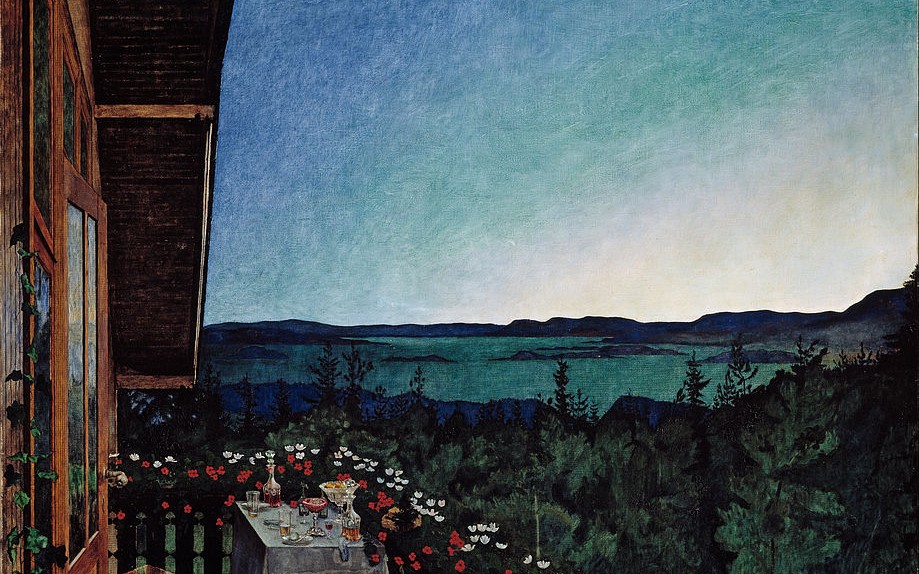“Now as I was young and easy under the apple boughs
About the lilting house and happy as the grass was green,
The night above the dingle starry,
Time let me hail and climb
Golden in the heydays of his eyes”
– Dylan Thomas, “Fern Hill”
Although there are no apple trees in Kalimpong, the little garden that we have gave us plums, peaches, and oranges, and as a I child, I did feel like un petit prince gamboling amidst these trees that were a comforting presence in my young life. After a decade away from home, the pandemic gave me an opportunity to once again roam these hallowed grounds. Although some of the peaches have festered and the oranges have been rendered cankerous, there is hope as I notice new saplings emerge from the ground.
A cousin of mine often visits a therapist/counsellor, and on his last visit, she suggested that he ‘expose himself to soil and dirt’. As ludicrous as it may sound, I could not help but wonder if there was some wisdom in those words. Apart from the smell of rain and the taste of fresh bread, I consider sinking one’s hands into cool earth as one of the little pleasures of life. What is the reason behind this appeal? Is it something instinctually primeval, or is it a modulated version of the death drive, to return to the soil from whence we came? Gardening is an interesting activity. Half the time, we are only concerned about what is prominent visually i.e., the fruits and the flowers. Oftentimes, we forget the rest of the story: the netherworld in terms of vegetation, the world beneath the grass so to speak. The roots that perform the miracle are often forgotten, but one must perhaps comprehend what exactly goes on in the soil. The nutrients that they absorb are but food that the microbes have broken down from a pre-existing life form such as an animal or a fruit or perhaps even a human. I often find myself ruminating about it while I am weeding in my garden in Kalimpong: how many life forms have died and new ones nourished by the earth, an eternal linkage of mouldering and miracles, like an ouroboros that goes on and on? Perhaps a handful of dirt contains a narrative larger than all the books that were there in Alexandria.
Gardening as a Form of Art
In an article by Lucia H. Albers, I came across the perception of gardening as an ideal form of art. Here, she notes the comment of a 17th century Dutch gardener called Jan van der Groen. It went like this, “Nature, which often demonstrates itself in a disorderly fashion, can be improved, embellished, made more amusing and ornamental by human effort.” The form of gardening that van der Groen appears to be referring to is landscape gardening: an arduous, albeit exalted, form of labour that encompasses architecture, weather, as well as horticulture, to say the least. If gardening is an attempt to refine Nature, I couldn’t help but wonder if it is a battle against the forces of ephemerality. We only read about the Hanging Gardens of Babylon, the ‘Pleasure Gardens’ beside the Nile, or even those of Pompeii. Nature always seems to win in the end, for we are trying to tame something that perhaps cannot be tamed. Furthermore, I would like to explore the human desire to enforce order in terms of gardening as an attempt to realise the eternal. For this, one need not look further than the Mughal gardens or those at the Alhambra palace where the layout and the symmetrical union between foliage and water is meant to imitate heaven on earth.
If a simplistic interpretation of art is that it consists in the imitation of Nature with the desire to invoke emotions, perhaps, gardening could be characterized as an art form. In fact, in 18th century Europe, gardening was elevated to the ranks of painting, sculpture, and poetry. Albers notes that Alexander Pope heralded the landscape designer Charles Bridgeman as an artist even higher than him. Pope considered gardening as a form of art more ancient and perhaps grander than poetry itself since it was closer to God’s work in his opinion. Unlike words that come alive from folios, gardening could be viewed as a more tangible, empirical form of art and, therefore, more imposing. Pope also appears to have stated that “gardening is landscape painting,” and it got me wondering if it were true. Just like the spatial limitations offered by poetry – in terms of empirical experiences – a painting is also limited to its one-dimensional surface and confined within the borders of a wooden frame. A landscape garden, on the other hand, like a sculpture, can be experienced and celebrated owing to its multi-dimensionality. Furthermore, like great studies of portraits, landscape paintings have never failed to express an artist’s emotions. For someone who modestly dabbles in landscape painting himself, I can vouch for this. A cool, blue lake reflecting slivers of pale light could evoke serenity while an all-consuming forest fire with cinder rising above it does not fail to evoke pain and anger within the viewer’s soul. To further add to this argument, I will refer to G.R.F. Ferrari’s essay “The Meaninglessness of Gardens” where he opines that a “gardener paints his landscapes with plants.” Ferrari notes that any art form has two distinctive components: materials and elements. If materials are the tools necessary to assist an art form (easel, paintbrushes, ruler in terms of painting and costumes, props and stage for dance, etc.), then elements comprise the core values (colours and tones for the former and rhythmic movements in terms of the latter) in any art form. Simply put, the elements of an art-form come together to compose the art. In that case, the soil, rocks, water, fences, and patio comprise the materials while the foliage and the plants themselves are the elements in the case of gardening. The art of gardening is such that it is perhaps the most unpredictable of all art forms since it deals with elements that are living, i.e., the lives of the plants. This unpredictability makes it challenging and, at the same time, the most dynamic of crafts. Unlike poetry and paintings that remain stagnant, a living garden is mutable and prone to change; its splendour grows with time. Here I am reminded of the landscape artist Arabella Lennox-Boyd, whose gardens of Gresgarth Hall in Lancaster are celebrated for their wild, natural layout. In an interview, she had said that, “You can’t control nature[…] I sort of fight against the idea that Nature was actually sometimes against one, but I suppose what I have learnt is that you can’t fight. You just have to accept it.”
Furthermore, Ferrari equates a garden to a society in terms of the dynamism of the plants as individuals that cohabit in harmony and, at the same time, also describes the art of gardening as a form of politics. Due to the variable nature of politics, gardening also requires a preparation for crisis and change and also strives towards a desire for a utopia. After all, isn’t a garden a symbolic representation of an idealistic utopia? Here, I am reminded of the Golden Age of Saturn or the prelapsarian Biblical world. Stability and harmony have always been portrayed as a pastoral garden of pleasures, which harks back to a period when men walked beside the divine in peace. During a recent Bible study session, a scholar explained to me how two pivotal moments in the Bible are depicted through a garden. As one may have guessed, the first is the garden of Eden from Genesis where the God of the Old Testament is portrayed as a gentle gardener walking amongst his nascent creation (Genesis 3:8) heralding the fall of man. This is then balanced out in the New Testament during the resurrection of Christ – after his sacrifice had atoned for mankind’s sins – when Mary Magdalene misidentifies Christ as ‘the gardener’ (John 20:15). A garden could thus be interpreted as a microcosmic kingdom of God with the Almighty as a nurturing figure that shapes, prunes, and plants his believers according to his grand design.
As grand and wonderful as this may sound, I have been disturbed by Ferrari’s comment that apart from the aesthetic pleasure one derives from gardens, they are basically meaningless. According to him, a garden symbolises nothing and has no internal degree of interpretation and this quality itself is partly why we find them so charming. Here, one may argue that a garden is actually a space replete with symbolism, from a rose representing passion to a cypress signifying death or the simple reason why Tibetans burn incense made from juniper or Catholics pray beside a sacred fountain. However, the meaninglessness of a garden, according to Ferrari, appears to be the reason why they are simply a space of reverie and leisure and the stage for other events to occur: “It is because gardens are art, yet tell no story of their own, that they serve so well as the setting for one.” This remark immediately reminded me of the orchard where the Senior Hamlet reposed while he was murdered, or the orchard where Horatio’s hanging body drove Isabella mad in The Spanish Tragedy or even the Capulets’ orchard where the doomed lovers of Verona sealed their fate. The garden of Gethsemane, The Secret Garden, Monet’s gardens in Giverny, Milton’s Eden, the chestnut tree at Thornfield Hall…the list goes on. Whether historical or literary, gardens appear to represent spaces for action to occur, almost like an arena of some sorts. This mutability is perhaps the reason behind the evolution of gardens from 18th century representations of aristocratic wealth to a space of leisure and egalitarian social activities post Industrial Revolution. In Europe as well as the rest of the world, gardens have been downgraded over the years and have shifted from adorning great country houses and abbeys to move into the cities as public spaces and parks. These days, we are more inclined towards backyards and rooftop gardens or little herb patches and, somehow, the grandiosity of landscape gardening has dissipated with the rise of socialism.
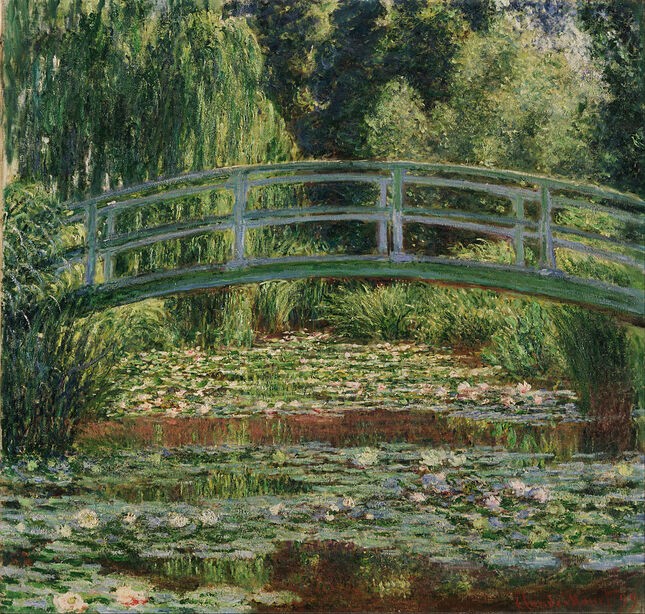
The Gardens of Giverny, Claude Monet
Can Great Gardens be Personal?
The popular art and design channel Nowness recently covered a series of videos titled “Great-Gardens” which showcased places such as Glin Castle, Gresgarth Hall, Trematon Castle, and Chatsworth House which made me wonder: can only aristocratic seats be considered as great gardens? Do scale and grandeur in terms of design and variety override the essence of a garden? I believe that such grandiosity in terms of scale renders such landscape feats as ‘public’ and not meant for personal delight. So then, what makes a garden personal? I think a personal garden should be a private space where one can disappear from the world for a while. It should feel natural, like a squirrel returning to its hollow or a bird returning to its nest. I would want to feel comforted and safe in such a space. Perhaps, I will be able to answer this question by delving into my past experiences and heritage to see how my life has been intrinsically linked with nature.
As a Lepcha, folktales were knitted into our social fabric, and the division between nature and civilization has always been evident in our stories. Tales were intended to teach us to respect the boundaries between the two realms, and the crossing over the threshold towards nature always evoked respect and caution. I could not help but relate our tribal cosmology to the way the old-world was divided in Beowulf: between Hrothgar’s illuminated hall where culture flourished and the icy marshes where Grendel and the darker elements of Nature reposed. Therein lay the balance between the two. The Lepcha creation myth narrates the ethereal valley of Mayel Lyang which was similar to the Garden of Eden which was lost after mankind’s fall, and the Lepchas see it as an idealised homeland/paradise. One particular story I grew up learning about is the fable of the Rhododendron who was rejected by an Alder tree in winter for appearing unattractive and gnarled. However, in spring, when the Alder witnessed the Rhododendron in full bloom, she was overcome with remorse and flung herself over a fresh landslide. I grew up admiring rhododendrons for their numerous properties. Their flowers are used to make juices and wine and there is this particular belief among the Lepchas that if one utters the tree’s name aloud, if there is a fishbone stuck in one’s throat it would pass down. This claim, however, remains contested.
Our Himalayan gardens are not as neat and manicured as the European ones. We have nettles, bamboo, and ferns growing alongside exotic plants, but they are all useful and the coexistence of these different plant species is part of my Lepcha-Nepali heritage. Take, for example, the usage of local weeds and plants for medicinal purposes. As a child, a bruise from a nasty fall simply required a few leaves of ‘banmārā’ (Eupatorium cannabium) to stop the bleeding while a nosebleed was instantly stopped when a few leaves of ‘titepāti’ (Artemisia vulgaris) were inserted into one’s nostrils. ‘Pākhanbed’ (Bergenia ciliate), as well as guava shoots cured one’s bad tummy, while in winter, our grandmother would put a drop of wild forest honey on a tulsi leaf for us to consume before bed. As a result, it would not be surprising to find such local shrubs growing alongside resplendent orchids and chrysanthemums in the hills.
My father was an officer in the Indian Forest Service and a keen botanist.
I would often look over his dusty volumes of Polunin and Stainton’s Flowers of the Himalayas (1984), Joseph Dalton Hooker’s The Flora of British India (1872), and The Rhododendrons of Sikkim-Himalaya (1849) along with manuals on orchid rearing. After his death, these books had been languishing ignominiously until I decided to reopen them to find his notes and readings. Thanks to him, I can now appreciate the beauty of orchids such as Dendrobium primulinum, Dendrobium densiflorum, Cymbidium longifolium, Coelogyne ochracea, and Coelogyne cristata.
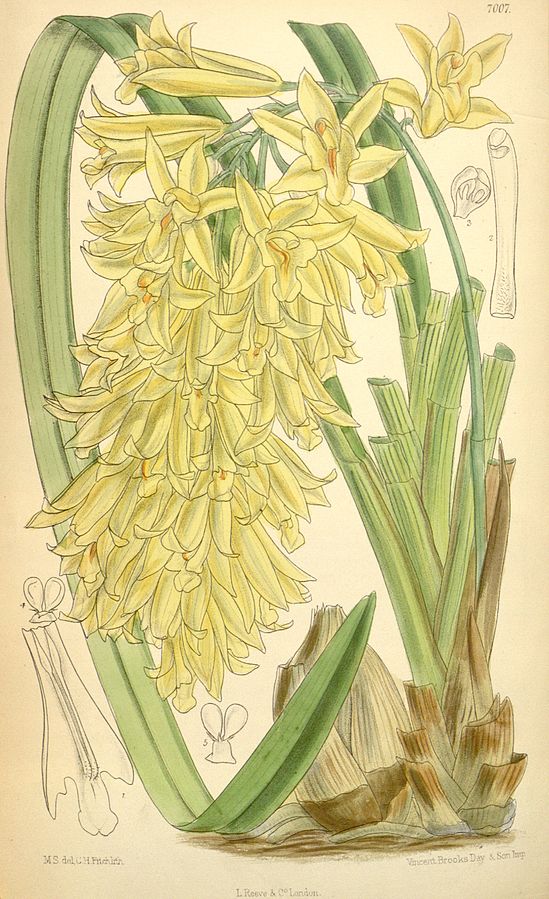
Cymbidium longifolium (as Cyperorchis elegans)
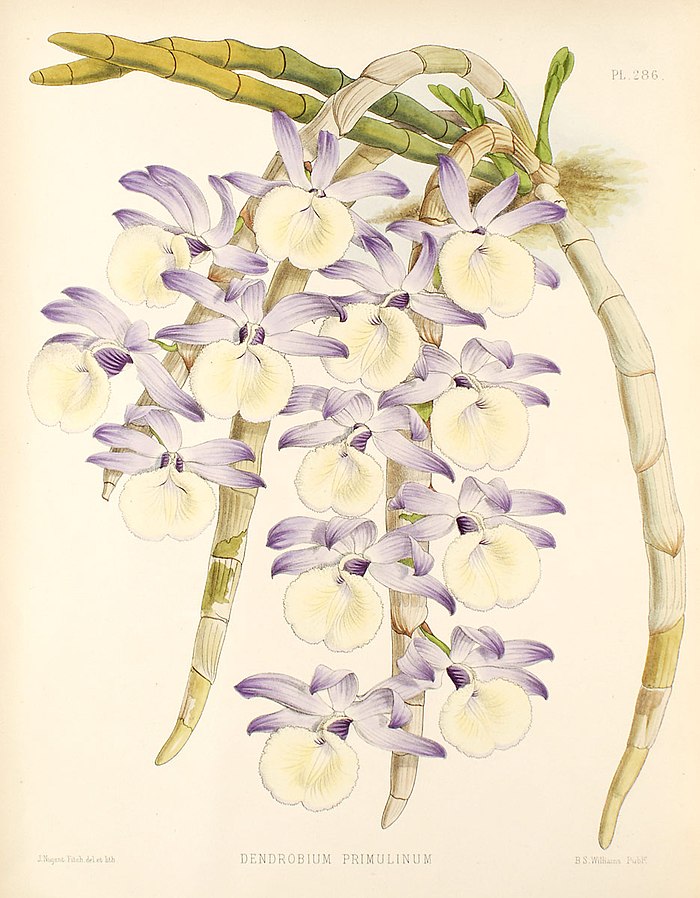
Every time I try to pronounce these names, I remember his voice during those late spring afternoons when he used to identify them to me. Grief can be strange sometimes; mine translated into a feeling of disdain towards orchids, and I could not bear to look at them for some years. Living in the city did not help either. Each day, I experienced a sense of disconnection with my surroundings until one day I felt as if I were trapped in an urban labyrinth. My version of Ariadne’s thread allowed me to trace back my roots and reconnect with nature. I decided to take a year off amidst the pandemic, and the general feedback I received was one of disapproval. Nevertheless, back at Kalimpong, I noticed how wild and derelict our garden had become. I began by extensively pruning and uprooting weeds till I decided to transfer flowering plants into the ground. I began by planting bougainvillea, rosemary, and azaleas. Then, I moved onto avocados and frangipani. I remember the first time I experienced the aroma of plumeria at a forest rest house in Naxalbari. The evening was hot, and I remember seeing ants crawling over the gravel. The delicate scent from that frangipani tree is something that has been deeply rooted in my memory. I had recently acquired a branch that I had left outside for one of its ends to form a callus before transferring it to the ground. To my surprise, without any roots or any source of nourishment, the bud had begun to blossom as it lay neglected for a few weeks. That’s the thing with nature. When I felt hurt and depressed, a leafless shoot of plumeria without any source of water taught me to bloom once again. The same goes for bougainvillea: they bloom harder if the conditions are arid. These plants taught me that unfavourable conditions are not an excuse for a lack in productivity, and every time I am struck with a spell of ennui, I remind myself of the frangipani and the bougainvillea.
As I was planting those white and red azaleas in my garden, I was reminded of Plath’s poem “Electra on Azalea Path” where she expresses a mélange of emotions: mourning, anger, and denial regarding her father’s death. The description of a barren grave with the “artificial red sage” and “plastic evergreens” dissolving in the rain has haunted me for some time. Here, I would like to revisit the argument with which I started this essay. Does it matter if a graveyard is adorned with flowers or bereft of any? I remember planting roses around my father’s grave, but I wonder if they have survived since my visits have become infrequent over the years. I write poems about mulberries bleeding, peaches rotting, and bitter orange seeds and thorns, and it seems to me that I have been using the metonymy of various flora to express my own raw emotions. With each poem I write and each shrub I plant, a little bit of those bottled emotions get released. The vines are my threads and the orange thorns my needle with which I am sewing myself back together. As hyperbolic as it may sound, I believe that gardening and poetry have saved me from falling into utter despair.
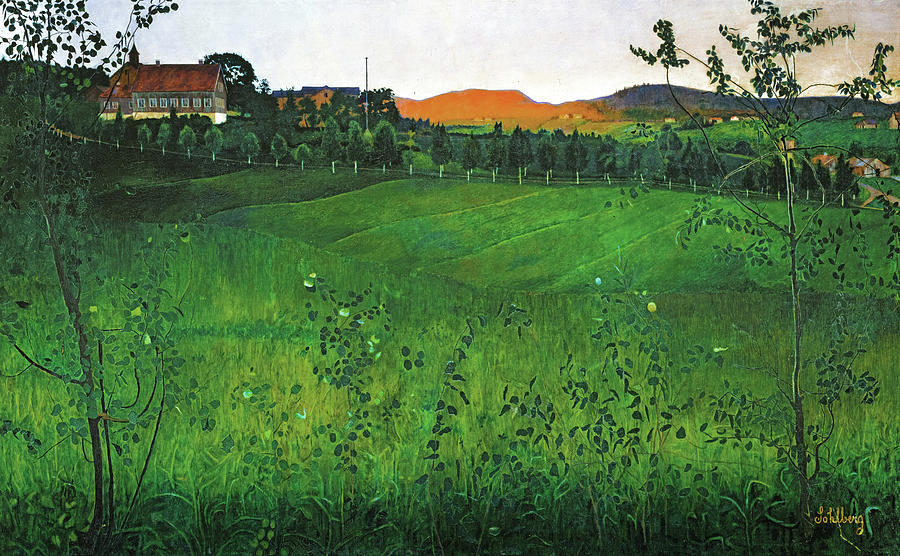
A Garden as a ‘Quiet Place’
I was recently reading an essay by Marsha Morton titled “German Romanticism: The Search for ‘A Quiet Place’” where she discussed how German Romanticism, as a movement, had begun as a form of escapism from the realities of Germany as a nation during the late 1790s. With the encroachment of France and the dissolution of Prussia by 1806, intellectuals and artists sought to unify a virtual country based on their commonality in terms of culture and art. A desire for a ‘quiet place’ can thus be viewed as a desire to revert to a state where culture, faith, and art could be nurtured once more following the ‘corruption’ of German aesthetics by French influences. As Morton notes, “Romantic artists chose to deal with unpleasant political realities by providing images of sanctuary that offered escape from the daily world,” and this vision of a sanctuary celebrated solitude and creative introspection along with mysticism in nature and the acquisition of knowledge through imagination. Romanticism dealt with natural vistas along with concepts such as the primal instincts, the sublime, the mystery, and the supernatural as a reaction to modernity. For such German Romantics, nature itself provided a spiritual amphora from where the wine of enlightenment flowed. One interesting concept that I encountered was their desire to equate plants and flowers to the innocence and naivety of children and, by extension, Edenic paradise. Flowers not only symbolised the cycle of death and renewal but also the desire to evoke the inner child within ourselves in order to cherish and encounter God. Morton refers to the ‘Nazarenes,’ an intellectual artistic group who revived 15th and 16th century Italian and German art and practiced a cloistered life in an abbey in San Isadora, Rome between 1810 and 1812 to facilitate art and spirituality.
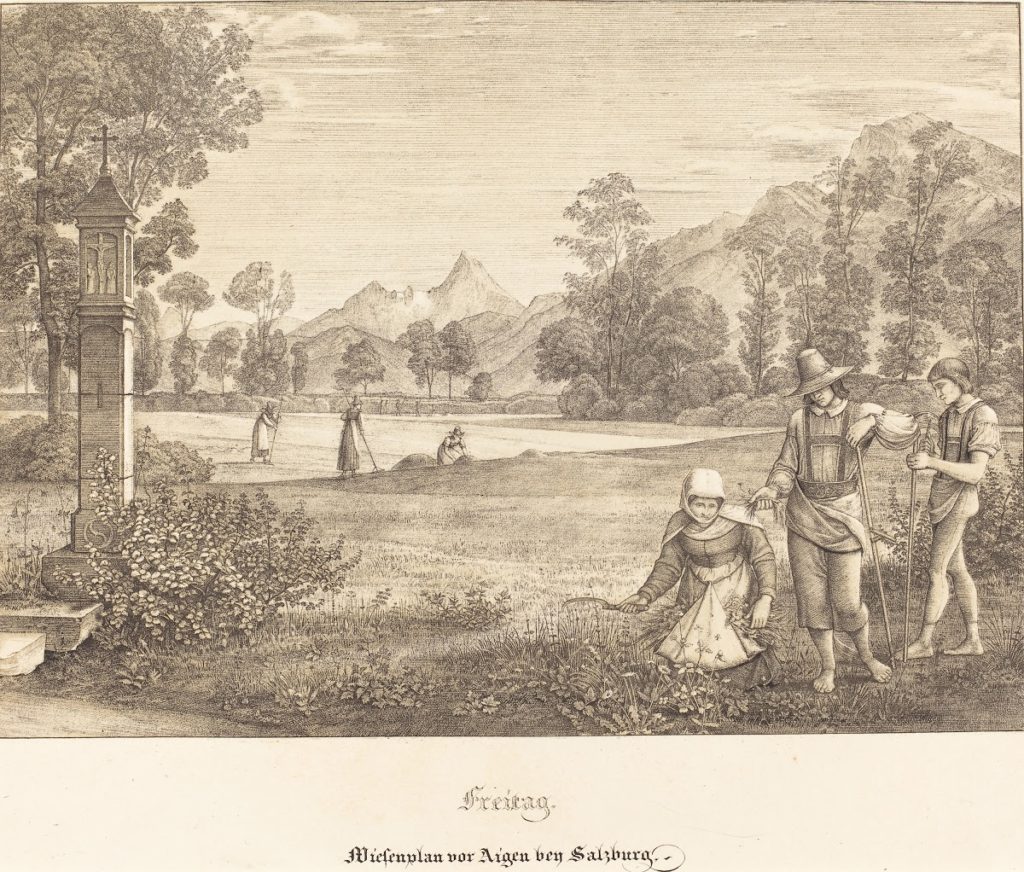
One particular Nazarene artist Ferdinand Olivier (1785-1841) really caught my eye, especially his series titled Seven Views in Salzburg and Berchtesgaden (1823). In this series, the paintings titled “Thursday: Berchtesgaden and the Watzmann” and “Friday: Meadow before Aigen near Salzburg” are of importance. In these artworks, Olivier unites spiritual imagery with a bucolic landscape to create a scene which is balanced, peaceful, and harmonious. In the first painting, the scene depicts a child carrying a cross in a garden, marked by flowering pots and a gardener grafting a tree with a sublime granite mountain in the backdrop. The second painting by Olivier portrays a pastoral scene of a meadow with farmers, trees, and a church tower of some sort. In both of these works, nature and the art of gardening are balanced with simplistic spiritual presence which invokes a wholesome emotion aligned to life in the countryside. I was similarly reminded of the Norwegian painter Harald Sohlberg’s (1869-1935) works such as “Ripe Fields” (1898), “Flower Meadow in the North” (1905), “Evening Glow,” (1893) and “Summer Night” (1899). I have always admired Sohlberg’s artwork where he took time to paint every individual leaf with precision and created a landscape devoid of humans. What we are left with are mysterious but idyllic locations where spirituality and a paroxysm of emotions thrive. Such paintings make me wonder if we also are in need of ‘a quiet place’.
When I read the newspapers about corpses floating down the Ganga or the growing religious and cultural intolerance in the country, or if I am going through a personal crisis, I simply feel like taking a walk around my garden. I realised that the pandemic has given this unique opportunity for me to once again reconnect with the good Earth and immerse myself in the profoundly aesthetic and life-sustaining pleasures of gardening. There is joy in the squelching of mud, to witness the dance of worms and the blooming of flowers in the morning. In this essay, I may have come across as an idealistic individual, but in my experience, my garden has been my solace and my salvation. I find peace there, and I also find the inspiration to write new poems or capture an evening, albeit poorly, on a canvas. One need not retire to the countryside or travel to the hills to get away from it all. All of us have our own urban private spaces such as backyards, rooftops, balconies, or even a window ledge to work with. Grow a few pots, water them, and feel the connection with the soil and the leaves. When you begin to handle the lives of plants, you will come to terms with how precious and mysterious your own life is. Each pot is a miniature miracle, with life and death swirling around it like the snake devouring its own tail, the inevitability of death and the infinitude of life.

